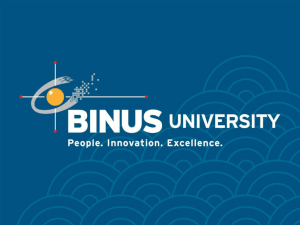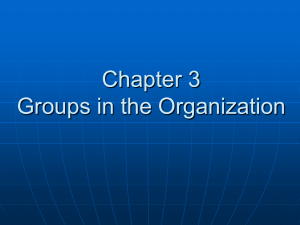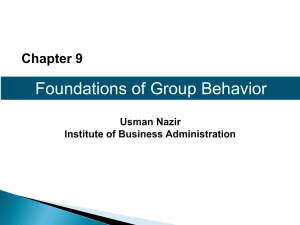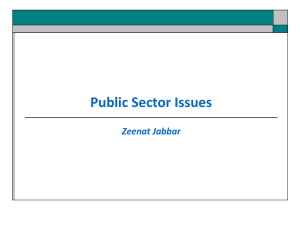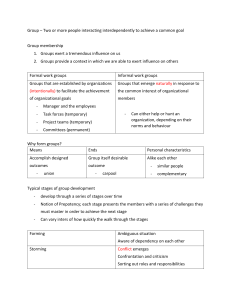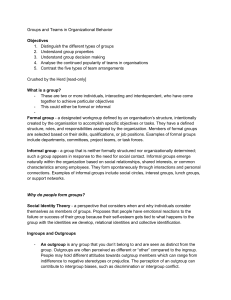Team Dynamics
advertisement
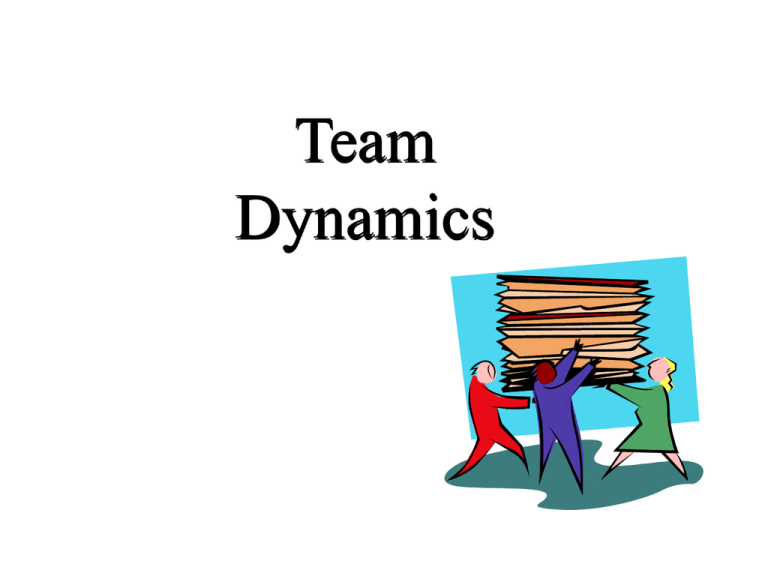
Team Dynamics Teams • • • • • What is a team? What makes a team effective? What makes a team defective? Why teams? Stages of team/group development What groups/teams do you belong to? What are Teams? • Groups of two or more people • Interact and influence each other • Are mutually accountable for achieving common objectives • Perceive themselves as a social entity What makes a team effective Great Groups vs “Not Great” Groups How do we define effective? Types of Teams Permanent teams – Team-based departments – Self-directed teams Task forces – Temporary teams that investigate a problem Skunkworks – Temporary teams – Formed spontaneously, using borrowed resources, to develop products or solve problems Virtual Teams • Cross-functional teams that operate across space, time and organizational boundaries using electronic technology • Increasingly possible because of: – Technology – Knowledge-based work • Increasingly necessary because of: – Globalization – Knowledge management – Need for team work Why Informal Groups Exist • Relatedness Needs – Fulfil need for social interaction – Social identity • Goal accomplishment • Emotional support Team Effectiveness Model Organizational and Team Environment Team Design • Reward systems •Task characteristics • Communication systems •Team size •Team composition • Physical space • Organizational environment • Organizational structure • Organizational leadership Team Processes •Team development •Team norms •Team roles •Team cohesiveness Team Effectiveness • Achieve organizational goals • Satisfy member needs • Maintain team survival Team Processes: Design Elements • Task characteristics – Better when tasks are clear, easy to implement – Task interdependence – Share common inputs, processes, or outcomes • Team size – Smaller teams are better – But large enough to accomplish task • Team composition – Members motivated/competent to perform task in a team environment – Team diversity Stages of Team Development Performing Norming Storming Forming Existing teams might regress back to an earlier stage of development Adjourning Conformity to Team Norms 100 Units Pressed per Hour Day 12: Peer pressure begins 75 Day 28: Employee has doubled performance 50 25 0 Day 20: Employee begins working alone Day 1: Employee begins job with team 4 8 12 16 20 24 28 Production Days 32 36 40 Changing Team Norms 1. Introduce norms when team formed 2. Select members with preferred norms 3. Discuss counterproductive norms 4. Rewards to support desired behaviours 5. Disband the team Causes of Team Cohesiveness Member Similarity External Challenges Team Success Member Interaction Team Cohesiveness Somewhat Difficult Entry Team Size Team Cohesiveness Outcomes Members of cohesive teams: • • • • • • Want to remain members Willing to share information Strong interpersonal bonds Want to support each other Resolve conflict effectively More satisfied and experience less stress J. Major, Ottawa Citizen Cohesiveness and Performance Team Norms Support Firm’s Goals Team Norms Oppose Firm’s Goals Moderately High Task Performance High Task Performance Moderately Low Task Performance Low Task Performance Low Team Cohesiveness High Team Cohesiveness The Trouble With Teams • Individuals better/faster on some tasks • Process losses — cost of developing and maintaining teams • Companies don’t support best work environment for team dynamics • Social loafing Conditions for Social Loafing • • • • • Low task interdependence Individual output not visible Routine, uninteresting tasks Low task significance Low collectivist values Types of Team Building • Role definition • Interpersonal process • Goal setting • Problem solving



